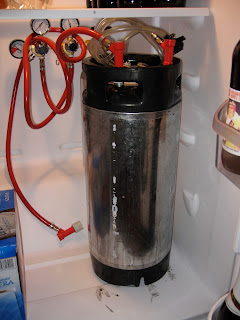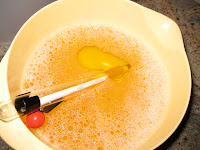Kicked off this session while watching the early NFL game. This was a bit easier than my last batch as it was all extract. No grain mashing which saves a couple of hours on the brew day. I was not really confident in my yeast pack (and rightfully so based on the late take off of the batch) but I had waited as long as I could.
For this batch I ended up using a Wyeast smack pack of Belgian Abbey (1762) Ale yeast. A smack pack is liquid yeast in a foil type bag. Inside the bag is a separate container of yeast nutrient that you "smack" to activate. This basically breaks the inner bag releasing food for the inactive cells. They then begin to grow, letting off CO2 which swells the bag. When it swells, you are good to go. It is usually pretty obvious, but this bag barely swelled at all.
 |
| Syrup and hard candy used for this recipe |
I did not want to wait any longer to brew so I hoped for the best and started cooking. This process is basically the same as the last beer I brewed, and I neglected to take any photos while cooking this time - my apologies. This recipe called for a couple of unique ingredients, one typical for the style and the other not so much. Belgians are often supplemented with sugar candy, I chose dark for this recipe to provide a little extra color and perhaps some deeper flavor. This recipe also called for maple syrup, which I have never used in beer. Not much was added, so we shall see if it is noted in the flavor. I would assume it will mostly ferment off, but we shall see.
The cook itself went off without incident. I had purchased a new floating thermometer when I picked up the ingredients and decided to use it to measure my cool down of the wort. I wanted to drop it in right after turning the heat off and then move the wort to the ice batch. That was a mistake. The thermometer bobbed under, touched the bottom of the pan which was still scorching hot, and you could hear it crack. I yanked it out quick and opted for plan B. I hung a meat probe down into the wort to monitor the cool down. when it registered under 80, I poured it off through a filter. I forgot the filter last time, which I assume is why my pale has way too much bite. You don't want all the hop remnants in your fermentor. I just needed a bit of water to top off to 5 gallons so added my cold water, pitched the yeast and moved the fermentor downstairs into a bathroom. My house is a little to cool for ideal temp for the Belgian, so I put it in a small interior bathroom, closed the door and opened up the heat vent full. Our heater is running pretty steady this week, so I figured it would raise the temp in there at least 5 degrees which is what I needed to get in my 70-75 range.
Next morning, no activity in the fermentor. Worse yet, it looked like some of the water in my lock had been pulled down into the fermentor. I was sure my temp reading was off (the fermentor did feel warm to the touch when I moved it) and the wort was too hot when I pitched. It cooled and sucked the water in from the lock. I was pretty sure I killed the yeast which led to the antics in my prior posts. Obviously I was wrong. The yeast just needed a little more time - perhaps it was a temp shock, but not enough to kill it. May end up better anyway. I have read that it is better for a Belgian to take it's time fermenting to invoke the proper esters from the yeasts into the beer. We will find out, but not for a while. This beer will transfer to a secondary a week after starting and then sit for 30 days before bottling. Hate to wait that long, but it will be worth it!



























